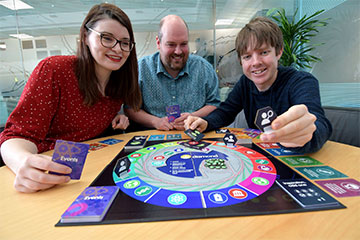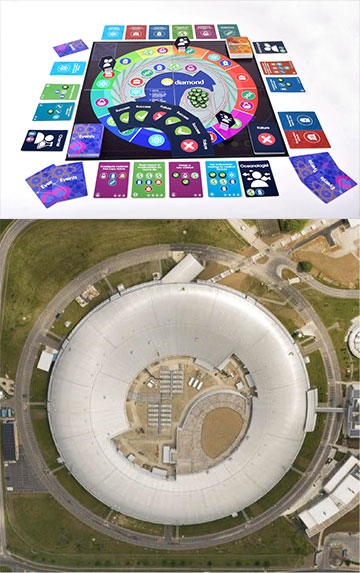
Claire Murray (left) and Mark Basham (middle) from the United Kingdom’s national synchrotron Diamond Light Source and Matthew Dunstan from the University of Cambridge, UK, playing “Diamond: The Game,” which they jointly created. [Image: Diamond Light Source]
A group of scientists based in the United Kingdom has developed a board game to help students aged 11 to 18 explore different facets of scientific research carried out at Diamond Light Source—the United Kingdom’s national synchrotron—scientific careers and the experiences of being a scientist (Research for All, doi: 10.14324/RFA.06.1.14). “Diamond: The Game” puts players into the shoes of Diamond researchers, taking them through different beamlines and various research projects, from physics to cultural heritage.
“Board games can be powerful, reusable and entertaining tools for directly engaging students and the public with scientific research,” said Claire Murray of Diamond Light Source in a press release. “Conveying cutting-edge science through play is not trivial, and the power of games to stimulate independent curiosity and conversation should not be underestimated.”
Virtual experience via board game
Tabletop games—such as board games and card games—have become a popular educational tool over the past decade. They allow participants to become active learners, exploring educational topics through game play and interactions with other players. This active participation is especially crucial when the educational goal of the game is to change players’ views.
The UK team developed “Diamond: The Game” to engage with students who are not able to visit the Diamond facility to observe scientific activities—an aim that became especially relevant in the era of the COVID-19 pandemic. As COVID-related restrictions have lifted, Diamond has resumed its “Inside Diamond” open house, which gives the public a chance to see inside its particle accelerator and experimental laboratories. But because the event is wildly popular, only a limited number of students can participate—and that’s where the board game comes in.
Developing the game
During initial brainstorming, the team decided to include four aspects of being a scientist and working at Diamond: the collaborative nature of Diamond, the uncertainty and pressure of performing experiments with time constraints, the range of experiments performed at Diamond, and the process of applying for and receiving experimental time at one of Diamond’s 34 beamlines.

Top: The game board. Bottom: An aerial image of the Diamond facility. [Image: Diamond Light Source (top); C. Murray et al (2022), Diamond Light Source (2021) (bottom)]
A graphic designer drew the game board based on the engineering floor plan of the Diamond facility. The colors around the board reflect the visible light spectrum and represent different zones around the synchrotron ring. Six areas of science practiced at Diamond—biology, chemistry, cultural heritage, earth science, energy and physics—were selected for inclusion in the game.
After the initial prototype, the game went through four iterations, improved at each step by test plays with over 50 individuals. The developers held specific test plays to check the game’s compatibility with players who have color-vision deficiency and/or sight impairments and a test play at a school for deaf and hard of hearing students.
The final game design consists of four card decks, one board, 12 scientist pieces, 50 “success” tokens and a rule book. During a game that takes about 20 to 30 minutes, a player selects a scientist, picks a project and moves around the beamlines to perform experiments. The player’s goal is to collect the necessary number of successes for their given project. When the player completes all requirements, they are given a set amount of fame. At the end of the game, the player with the most fame from completed projects becomes the winner.
Changing young minds
To understand whether or not the game could change students’ perceptions of science and STEM (science, technology, engineering and mathematics) careers, the developers worked with 222 students and their teachers. Before and after playing the game, students filled out a questionnaire with three yes-or-no responses—“Would you be a scientist or engineer?,” “I like science,” “I see science in my daily life”—and one one-word-answer response—“Being a scientist means…”
The results showed that a short game play did not change the students’ like or dislike of science. However, out of 82 students who indicated that they would not like to be a scientist or engineer before the game, 22 students positively changed their answer after playing the game, with only 5 negative changes. The game also impacted students’ recognition of science in their daily lives; of the 30 students who didn’t see science in their daily lives, 16 changed their response positively, while only one student changed negatively.
Students’ one-word answers to what being a scientist means changed before and after playing the game as well. Before the game, the most frequently mentioned words were “smart,” “experiments” and “research,” which represent stereotypical characteristics of scientists and the scientific process. In comparison, the most popular words after the game were “collaboration,” “success” and “failure,” better reflecting the reality of scientists’ daily lives. The game developers write that these answers are particularly powerful, as they show that the students realized that the life of a STEM researcher is not so different from that of a professional in another field.
The developers say that their game is a valuable resource in learning environments, especially as there is evidence that children as young as seven make career-limiting decisions. The game is available for free as a print-and-play version, and a boxed version is currently being distributed to 100 schools in underserved areas of the United Kingdom, according to the press release.
